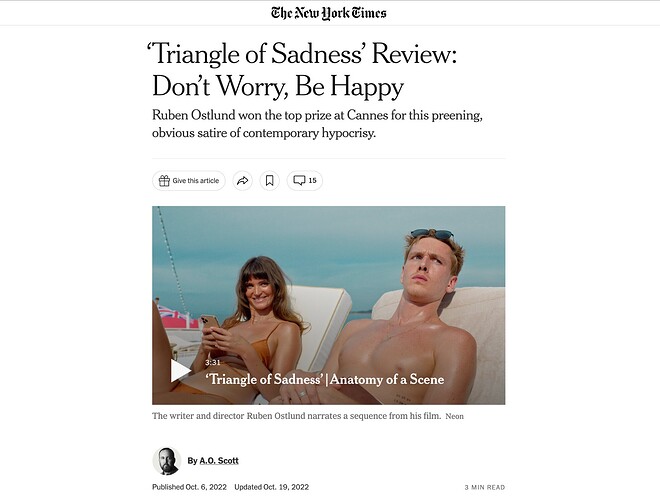-
《悲情三角》是鲁本-奥斯特伦德的一部电影,是对 "吉利根岛 "的蓬头垢面的艺术院线重启。
-
该片对超模的浅薄、俄罗斯寡头的粗俗和全球消费资本主义的残酷不平等有许多见解。
-
这部电影在最愚蠢的时候是最好的,但奥斯特伦德适度的喜剧技巧被拴在了宏大的讽刺意图上。
-
奥斯特伦德是一个有影响力的人,而不是一个有影响力的电影人。
-
最后一幕发生在似乎是一个未知的沙漠小岛的海岸上,在那里,幸存者们义务地表演了一个关于权力和人性的寓言故事。
-
最后一幕是电影中最好的部分,部分原因是奥斯特伦允许角色表现得像人,而不是在他玩世不恭的道德游戏中只是怪诞的密码。
-
这部电影很糟糕,执行起来有足够的视觉效果和表面的聪明才智,可以骗过戛纳电影节的评委,这一点奥斯特伦德已经做了两次。
-
“Triangle of Sadness” is a film by Ruben Ostlund that is a shaggy-dog art-house reboot of “Gilligan’s Island”.
-
The film has many insights to offer about the shallowness of supermodels, the vulgarity of Russian oligarchs and the brutal inequality of global consumer capitalism.
-
The film is best when it’s silliest, but Ostlund’s modest comic skills are tethered to grandiose satirical intentions.
-
Ostlund is an influencer, not an influential filmmaker.
-
The final act takes place on the shores of what seems to be an uncharted desert isle, where the survivors obligingly act out an allegory about power and human nature.
-
The final act is the best part of the movie, partly because Ostlund allows the characters to behave like people, rather than just grotesque ciphers in his cynical morality play.
-
The movie is bad and executed with enough visual polish and surface cleverness to fool the Cannes jurors, something Ostlund has done twice.
链接:‘Triangle of Sadness’ Review: Don’t Worry, Be Happy - The New York Times
